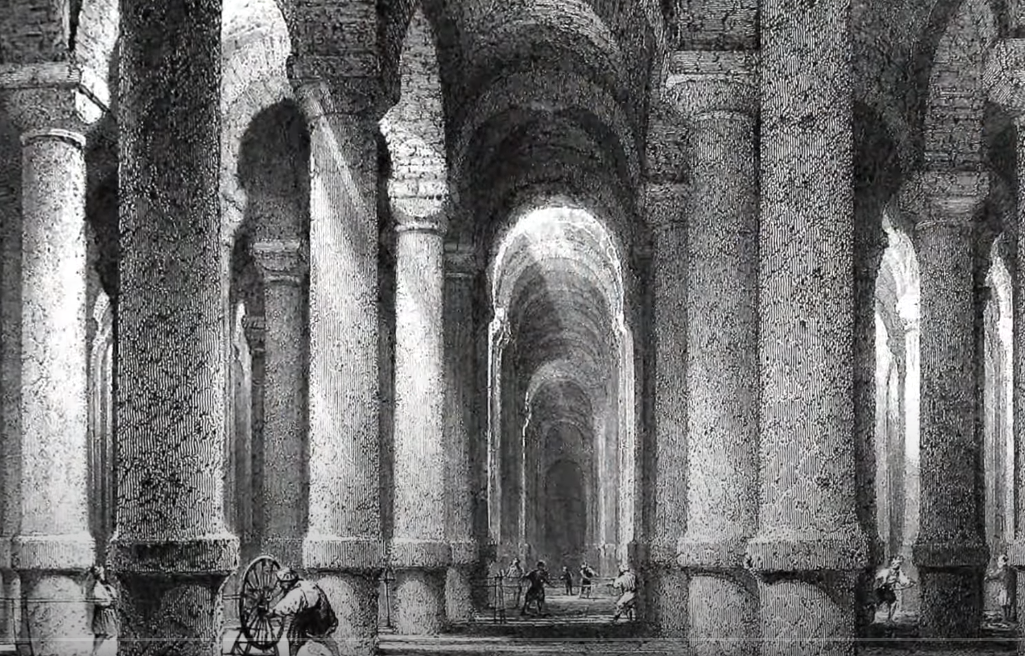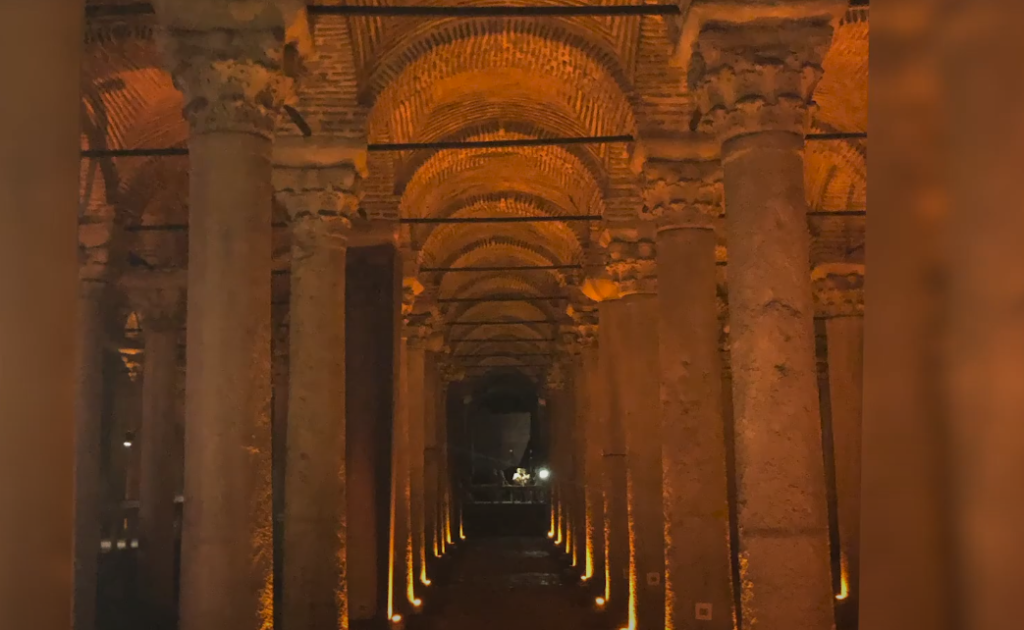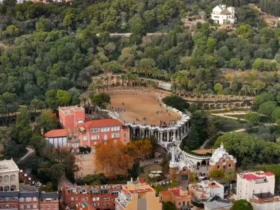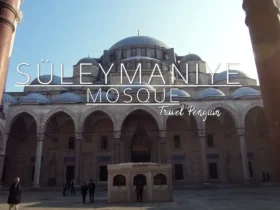The Basilica Cistern in Turkey is an ancient underground water reservoir. It was built in 532 AD during the Byzantine Empire.
The Basilica Cistern, located in Istanbul, is a marvel of ancient engineering. Emperor Justinian I commissioned its construction to supply water to the Great Palace. The cistern measures 140 meters by 70 meters and can hold up to 80,000 cubic meters of water.

Its 336 marble columns, each nine meters tall, create a mesmerizing underground forest. Two Medusa head carvings, repurposed as column bases, add to its mystical allure. The site, now a popular tourist attraction, offers a unique glimpse into Byzantine history and architecture. Visitors can explore its walkways and enjoy the serene, almost otherworldly atmosphere.
Historical Significance
The Basilica Cistern in Turkey is a hidden gem beneath the bustling streets of Istanbul. This ancient underground water reservoir has fascinated visitors for centuries. Its rich history and architectural beauty make it a must-see site. The History of Basilica Cistern, Turkey, dates back to the Byzantine era. It continued to play a crucial role during the Ottoman period. Let’s explore its historical significance in more detail.
Byzantine Era
The Basilica Cistern was constructed during Emperor Justinian I’s reign in 532 AD. It served as a water filtration system for the Great Palace of Constantinople. This cistern could hold up to 80,000 cubic meters of water. Water was supplied from the Belgrade Forest, located 19 kilometres away, via aqueducts.
Table of Contents
Key features of the Byzantine Era:
- The cistern measures 140 meters long and 70 meters wide.
- It has 336 marble columns, each 9 meters high.
- Each column is spaced 4.8 meters apart.
Visitors today can still see the intricate carvings on these columns. The Medusa heads, used as column bases, are particularly striking. These heads are thought to be repurposed from earlier Roman structures.
Ottoman Influence
During the Ottoman period, the Basilica Cistern continued to serve as a water source. After the conquest of Constantinople in 1453, the Ottomans maintained the cistern. They recognized its importance in providing water to the city. Sultan Suleiman the Magnificent ordered repairs to the structure in the 16th century.
Notable Ottoman contributions include:
- Regular maintenance and cleaning of the cistern.
- Additions of water channels to improve water flow.
- Integration into the city’s evolving water supply system.
Today, the Basilica Cistern visiting hours in Turkey are designed to accommodate tourists from around the world. Visitors can walk on wooden platforms above the water. The dimly lit environment, with soft classical music, adds to the mystical ambience.

Architectural Features
The Basilica Cistern in Turkey is one of Istanbul’s most fascinating historical sites. This underground marvel dates back to the 6th century during the reign of Emperor Justinian I. The cistern is famous for its architectural features, which are both impressive and mysterious. Visitors from around the world come to marvel at its intricate design and engineering. The Basilica Cistern’s unique features make it a must-see destination for anyone interested in ancient architecture.Basilica Cistern in TurkeyBasilica Cistern in TurkeyBasilica Cistern in Turkey
Design Elements
The design elements of the Basilica Cistern are both beautiful and functional. The cistern features 336 marble columns that support its vast ceiling. These columns are arranged in 12 rows, each containing 28 columns. Each column stands at an impressive height of 9 meters.
Many columns are decorated with intricate carvings and designs. Some even feature unique motifs, like Medusa heads, placed at the base of two columns, adding a touch of mystery to the site.
Here are some notable design elements:
- Marble Columns: 336 columns, each 9 meters high.
- Medusa Heads: Located at the base of two columns.
- Carved Motifs: Various intricate designs on many columns.
The cistern’s ceiling is an impressive brick vaulted structure. This design not only supports the weight above but also adds to the cistern’s aesthetic appeal. The floor is covered with a layer of water, creating a reflective surface that enhances the site’s beauty.
Structural Innovations
The Basilica Cistern’s structural innovations are a testament to ancient engineering. One of the most notable features is its water filtration system. This system ensured that clean water was available for the city, which was crucial for its survival.
The cistern could hold 80,000 cubic meters of water. This vast storage capacity was essential for meeting the needs of the city during dry periods. The cistern’s walls are 4 meters thick and made of a special waterproof mortar. This construction method prevented water leakage, ensuring a reliable water supply.
Here are some key structural innovations:
Feature
Description
Water Filtration System Ensured clean water for the city.
Storage Capacity: 80,000 cubic meters of water.
Thick walls are 4 meters thick, and they are waterproof mortar.
Visitors today can marvel at these innovations and appreciate the details of the Basilica Cistern underground architecture. The best time to visit the Basilica Cistern is during the morning hours when it is less crowded. This allows for a more peaceful and immersive experience.

Art And Sculpture
The Basilica Cistern in Turkey is a marvel of ancient engineering. It is an underground water reservoir. Visitors are amazed by its art and sculpture. The cistern is filled with many beautiful and mysterious pieces. Let’s explore two of the most famous features: the Medusa Heads and the Column Designs.
Medusa Heads
One of the most intriguing features of the Basilica Cistern in Turkey is the Famous Medusa heads Basilica Cistern. These heads are carved from stone and have a rich history. They are located at the base of two columns in the cistern. The heads are turned sideways and upside down. Scholars think this was done to nullify the power of Medusa’s gaze. Here are some key points about the Medusa heads:
- The heads are believed to be from the late Roman period.
- They were repurposed for the cistern, not originally made for it.
- Their purpose and origin are still a mystery.
These heads add to the mystique of the cistern. Many visitors come specifically to see them. The Basilica Cistern tour guide information often highlights these heads. They are a must-see for anyone visiting the cistern.
Column Designs
The Basilica Cistern in Turkey is supported by 336 columns. Each column is a marvel of ancient design. The columns are made of Marble and other stones. They are arranged in 12 rows of 28 columns each. Here are some interesting facts about the column designs:
Feature
Description
Materials: Marble, granite, and other stones
Height Around 9 meters (30 feet)
Design Some columns have intricate carvings
The columns are not uniform in design. Some are plain, while others have detailed carvings. These carvings include shapes of leaves and other patterns. The variety in column designs makes the cistern even more fascinating. Visitors can spend hours admiring the artistry. The column designs are a testament to the skill of ancient builders.Basilica Cistern in TurkeyBasilica Cistern in TurkeyBasilica Cistern in Turkey

Tourist Experience
The Basilica Cistern in Turkey is a historic underground reservoir in Istanbul. Built during the Byzantine Empire, it is a marvel of ancient engineering. Many tourists visit to see its impressive architecture and eerie atmosphere. The cistern is famous for its hundreds of marble columns and the mysterious Medusa heads at its base. Visitors often leave mesmerized by its beauty and history.
Visitor Information
Many people want to know how to reach Basilica Cistern, Turkey. It is located near the Hagia Sophia and the Blue Mosque in Istanbul’s Sultanahmet district. Public transportation is very convenient.
- By Tram: Take the T1 tram line to the Sultanahmet stop.
- By Bus: Many buses stop near the Blue Mosque.
- By Foot: It is a short walk from many major sites in Sultanahmet.
It is also important to know the entrance fee for the Basilica Cistern. The cost is 20 Turkish Lira for adults, and children under 12 enter for free. The cistern is open every day from 9:00 AM to 5:30 PM, so it is best to visit early to avoid crowds.
Guided Tours
Guided tours offer a deeper understanding of the Basilica Cistern. Many tours are available in multiple languages and provide fascinating insights into the cistern’s history and architecture.
Tour guides explain the significance of the Medusa heads and other features. Some tours include visits to nearby attractions like the Hagia Sophia and Blue Mosque.
Booking a tour is easy. Many online platforms offer reservations. You can also join a tour group at the entrance. Guided tours usually last about an hour and are a great way to enhance your visit and learn more about this amazing site.
Cultural Impact
The Basilica Cistern in Turkey is an ancient underground water reservoir. It was built in the 6th century during the reign of Byzantine Emperor Justinian I. This marvel of engineering has not only served practical purposes but also significantly influenced culture. This blog post explores its cultural impact, especially in literature and film.Basilica Cistern in TurkeyBasilica Cistern in TurkeyBasilica Cistern in Turkey
In Literature
The Basilica Cistern in Turkey has inspired many writers. Its mysterious and eerie atmosphere makes it a perfect setting for novels and stories. Dan Brown’s novel “Inferno” prominently features the cistern. The book takes readers through the dark, damp corridors, adding to the suspense and thrill.
Other authors also use the cistern to add a sense of history and depth to their works. Travel guides and history books often mention the cistern. They describe its architectural beauty and historical significance.
- Dan Brown’s “Inferno” – A thrilling chase through the cistern.
- Historical novels – Often set scenes in the cistern to evoke a sense of past grandeur.
- Travel literature – Guides and travelogues highlight its unique charm.
These literary works encourage more people to visit and appreciate the Basilica Cistern in Turkey.
In Film
Filmmakers love the Basilica Cistern in Turkey for its dramatic and unique setting. The cistern’s vast underground space, dim lighting, and reflective waters create a magical atmosphere. The James Bond movie “From Russia with Love” features scenes shot in the cistern. The film uses the cistern’s mysterious setting to heighten tension and drama.
Other movies also use the cistern to evoke a sense of mystery and adventure. Documentary filmmakers often feature the cistern to educate viewers about its historical and architectural significance.
- James Bond’s “From Russia with Love” – Key scenes set in the cistern.
- Documentaries – Highlight its engineering and historical importance.
- Adventure films – Use the cistern for its mysterious and eerie ambience.
The Basilica Cistern in Turkey continues to inspire and captivate audiences through its film appearances.
Frequently Asked Questions
What Is The Basilica Cistern?
The Basilica Cistern is an ancient underground water reservoir in Istanbul, Turkey.
How Old Is The Basilica Cistern?
The Basilica Cistern was built in the 6th century during the reign of Emperor Justinian I.
How Big Is The Basilica Cistern?
The Basilica Cistern measures approximately 138 meters long and 64. 6 meters wide.
What Are The Medusa Heads In The Cistern?
The Medusa heads are stone column bases in the Basilica Cistern, believed to be from Roman ruins.
Is The Basilica Cistern Worth Visiting?
Yes, the Basilica Cistern offers a unique historical and architectural experience in Istanbul.
Conclusion
The Basilica Cistern in Turkey offers a mesmerizing glimpse into ancient engineering. Its beauty and history captivate every visitor. Don’t miss this hidden gem on your next trip. Experience the blend of mystery and marvel. Plan your visit now to witness one of Istanbul’s most enchanting sites.









Leave a Review